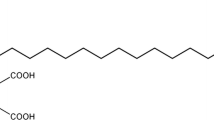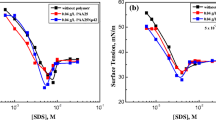Abstract
A series of new non-ionic amphiphiles based on bis-galactobenzimidazolones have been synthesized by grafting alkyl bis-benzimidazolone units as hydrophobic tails on hydroxypropyloxygalacto-pyranose moieties as hydrophilic heads. Their surface and self-aggregation properties in water were evaluated. The compounds show very low critical micellar concentrations (CMCs) that decrease with increasing chain length; values for the minimal area per molecule at the interface (A min) follow the same trend. The synthesized compounds also form hexagonal liquid crystals in water for a certain range of hydrophobic tail lengths. On the other hand, the new amphiphiles show characteristic UV–Vis absorption and fluorescence emission bands associated with the benzimidazolone moiety. The fluorescence emission is quenched with a certain degree of selectivity by cations, due to their strong affinity towards the benzimidazolone group, which shows ion complexation properties. Hence, the reported new amphiphiles are candidates as self-assembling chemosensors. The quenching efficiency and also ion sensing sensitivity is higher in the monomeric state as compared to the micellar state. The fluorescence emission intensity is higher for compounds with a shorter alkyl chain.






Similar content being viewed by others

References
Rodríguez-Abreu C, Aramaki K, Tanaka Y, Lopez-Quintela MA, Ishitobi M, Kunieda H (2005) Wormlike micelles and microemulsions in aqueous mixtures of sucrose esters and nonionic cosurfactants. J Colloid Interf Sci 291:560–569
Rauter AP, Lucas S, Almeida T, Sacoto D, Ribeiro V, Justino J, Neves A, Silva FV, Oliveira MC, Ferreira MJ, Santos M-S, Barbosa E (2005) Synthesis, surface active and antimicrobial properties of new alkyl 2, 6-dideoxy-l-arabino-hexopyranosides. Carbohydr Res 340:191–201
Van Hamme JD, Singh A, Ward OP (2006) Physiological aspects: part 1 in a series of papers devoted to surfactants in microbiology and biotechnology. Biotechnol Adv 24:604–620
Singh A, Van Hamme JD, Ward OP (2007) Surfactants in microbiology and biotechnology: Part 2. Application aspects. Biotechnol Adv 25:99–121
Różycka-Roszak B, Jurczak B, Wilk KA (2007) Effects of nonionic sugar surfactants on the phase transition of DPPC membranes. Thermochim Acta 453:27–30
Ren X, Mao X, Cao L, Xue K, Si L, Qiu J, Schimmer AD, Li G (2009) Nonionic surfactants are strong inhibitors of cytochrome P450 3A biotransformation activity in vitro and in vivo. Eur J Pharm Sci 36:401–411
Jiao J (2008) Polyoxyethylated nonionic surfactants and their applications in topical ocular drug delivery. Adv Drug Deliver Rev 60:1663–1673
Tracy DJ, Ruoxin L, Yang JY (1999) Nonionic Gemini surfactants having multiple hydrophobic and hydrophilic sugar groups. US Patent 5863886
Bais D, Trevisan A, Lapasin R, Partal P, Gallegos C (2005) Rheological characterization of polysaccharide-surfactant matrices for cosmetic O/W emulsions. J Colloid Interf Sci 290:546–556
Ahsan F, Arnold JJ, Meezan E, Pillion DJ (2003) Sucrose cocoate, a component of cosmetic preparations, enhances nasal and ocular peptide absorption. Int J Pharm 251:195–203
Uchegbu IF, Vyas SP (1998) Non-ionic surfactant based vesicles (niosomes) in drug delivery. Int J Pharm 172:33–70
Wu D-Q, Lu B, Chang C, Chen C-S, Wang T, Zhang Y-Y, Cheng S-X, Jiang X-J, Zhang X-Z, Zhuo R-X (2009) Galactosylated fluorescent labeled micelles as a liver targeting drug carrier. Biomaterials 30:1363–1371
Nakamura N, Yamaguchi Y, Hakansson B, Olsson U, Tagawa T, Kunieda H (1999) Formation of microemulsion and liquid crystal in biocompatible sucrose alkanoate systems. J Disper Sci Technol 20:535–557
Stradner A, Mayer B, Sottmann T, Hermetter A, Glatter O (1999) Sugar surfactant-based solutions as host systems for enzyme activity measurements. J Phys Chem B 103:6680–6689
Castro MJL, Kovensky J, Fernández-Cirelli A (2002) New family of nonionic gemini surfactants. Determination and analysis of interfacial properties. Langmuir 18:2477–2482
Terefenko EA, Kern J, Fensome A, Wrobel J, Zhu Y, Cohen J, Winneker R, Zhang Z, Zhang P (2005) SAR studies of 6-aryl-1,3-dihydrobenzimidazol-2-ones as progesterone receptor antagonists. Bioorg Med Chem Lett 15:3600–3603
Monforte AM, Rao A, Logoteta P, Ferro S, De Luca L, Barreca ML, Iraci N, Maga G, De Clercq E, Pannecouque C, Chimirri A (2008) Novel N1-substituted 1,3-dihydro-2H-benzimidazol-2-ones as potent non-nucleoside reverse transcriptase inhibitors. Bioorg Med Chem 16:7429–7435
Li S-K, Ji Z-Q, Zhang J-W, Guo Z-Y, Wu W-J (2010) Synthesis of 1-Acyl-3-isopropenylbenzimidazolone derivatives and their activity against Botrytis cinerea. J Agric Food Chem 58:2668–2672
Meth-Cohn O, Smith DI (1982) N-bridged heterocycles. Part 5.α,ω-bis-(2-oxobenzimidazolinyl)-alkanes and -ethers as selective ligands for group-1 and -2 metals, J Chem Soc Perkin I 261–270
Lazar Z, Benali B, Elblidi K, Zenkouar M, Lakhrissi B, Massoui M, Kabouchi B, Cazeau-Dubroca C (2003) Photophysical study of benzimidazolone and its derivative molecules in solution. J Mol Liq 106(1):89–95
Benali B, Lazar Z, Elblidi K, Lakhrissi B, Massoui M, Elassyry A, Cazeau-Dubroca C (2006) Solvatochromic effect on photophysical properties of benzimidazolone. J Mol Liq 128:42–45
Mancin F, Rampazzo E, Tecilla P, Tonellato U (2006) Self-assembled fluorescent chemosensors. Chem Eur J 12:1844–1854
El Majzoub A, Cadiou C, Déchamps-Olivier I, Chuburu F, Aplincourt M, Tinant B (2009) Mono- and bis-N-functionalised cyclen with benzimidazolylmethyl pendant arms: sensitive and selective fluorescent probes for zinc and copper ions. Inorg Chim Acta 362:1169–1178
Pina F, Bernardo MA, García-España E (2000) Fluorescent chemosensors containing polyamine receptors. Eur J Inorg Chem 2143–2157
Lakhrissi B, Ejjiyar S, Massoui M, Comelles F, Garcia MT, Ribosa I, Azemar N, Solans C (2002) Surface and self-aggregation properties of bis-benzimidazolone derivatives of d-glucose. Jorn Com Esp Deterg 32:365–373
Lakhrissi L, Lakhrissi B, Lakhrissi M, Massoui M, Essassi EM, Solans C, Azemar N, Morales D, Comelles F (2007) Synthesis and evaluation of surfactants properties of new amphiphile and bolaamphiphile derivatives of bis-glucobenzimidazolones. Jorn Com Esp Deterg 37:347–353
Lakhrissi B, Benksim A, Massoui M, Essassi EM, Lequart V, Joly N, Beaupère D, Wadouachi A, Martin P (2008) Towards the synthesis of new benzimidazolone derivatives with surfactant properties. Brahim Lakhrissi. Carbohydr Res 343:421–433
Lakhrissi B, Lakhrissi L, Massoui M, Essassi EM, Comelles F, Esquena J, Solans C, Rodriguez-Abreu C (2010) Surface and self-aggregation properties of bis-benzimidazolones derivatives of d-glucose. J Surfact Deterg 13:329–338
Goueth PY, Ronco G, Villa P (1994) Synthesis of novel bis(glycosyl) ethers as bolaamphiphile surfactants. J Carbohydr Chem 13:679–696
Lakhrissi B, Essassi EM, Massoui M, Goethals G, Lequart V, Monflier E, Cecchelli R, Martin P (2004) Synthesis and amphiphilic behavior of N, N-bis-glucosyl-1,5-benzodiazepin-2,4-dione. J Carbohydr Chem 23:389–401
Köll P, Saak W, Pohl S, Steiner B, Miroslav Koos M (1994) Preparation and crystal and molecular structure of 6-O-[(2S)-2, 3-epoxypropyl]-1,2:3,4-di-O-isopropylidene-α-d galacto-pyranose. Pyranoid ring conformation in 1,2:3,4-di-O-isopropylidene galactopyranose and related systems. Carbohyd Res 265:237–248
Baggett N, Buck KW, Foster AB, Jefferis R, Rees BH, Webber JM (1965) Aspects of stereochemistry. Part XIX. Isopropylidene derivatives of some polyhydric alcohols. Observations on the hydrolytic behaviour and migration of cyclic ketals. J Chem Soc 3382–3387
Rosen MJ (1989) Surfactant and interfacial phenomena, 2nd edn. Wiley, New York
Lu JR, Thomas RK, Penfold J (2000) Surfactant layers at the air/water interface: structure and composition. Adv Colloid Interf Sci 143–304
Fabbrizzi L, Licchelli M, Pallavicini P, Perotti A, Taglietti A, Sacchi D (1996) Fluorescent sensors for transition metals based on electron-transfer and energy-transfer mechanisms. Chem Eur J 2:75–82
Zhou LL, Sun H, Zhang XH, Wu SK (2005) An effective fluorescent chemosensor for the detection of copper(II). Spectrochim Acta A 61:61–65
Stern O, Volrner M (1919) The fading time of fluorescence. Z Phys 20:183–188
Lakowicz JR, Weber G (1973) Quenching of fluorescence by oxygen. Probe for structural fluctuations in macromolecules. Biochemistry 12:4161–4170
Tan C, Pinto MR, Schanze KS (2002) Photophysics, aggregation and amplified quenching of a water-soluble poly(phenylene ethynylene). Chem Commun 446–447
Pu S, Li M, Fan C, Liu G, Shen L (2009) Synthesis and the optoelectronic properties of diarylethene derivatives having benzothiophene and n-alkyl thiophene units. J Mol Struct 919:100–111
Iwunze MO, Lambert M, Silversmith EF (1997) Characterization of fluorescent surfactant aggregates by fluorimetric and viscosimetric techniques. Monatsh Chem 128:585–592
Acknowledgments
This work was supported by CNRST-CSIC project (2007MA0055). The “Ministère Marocain de l’Enseignement Supérieur” is gratefully acknowledged. C.R-A is also grateful to the Ministerio de Ciencia e Innovación, Spain (Project CTQ2008-01979/BQU) for research funding. J.M.R and N. H. thank Direccion Xeral de Promoción Científica e Tecnológica del sistema Universitario de Galicia for their financial support.
Author information
Authors and Affiliations
Corresponding author
Electronic supplementary material
Below is the link to the electronic supplementary material.
About this article
Cite this article
Lakhrissi, L., Hassan, N., Lakhrissi, B. et al. Surfactants Based on Bis-Galactobenzimidazolones: Synthesis, Self-Assembly and Ion Sensing Properties. J Surfact Deterg 14, 487–495 (2011). https://doi.org/10.1007/s11743-011-1262-7
Received:
Accepted:
Published:
Issue Date:
DOI: https://doi.org/10.1007/s11743-011-1262-7



